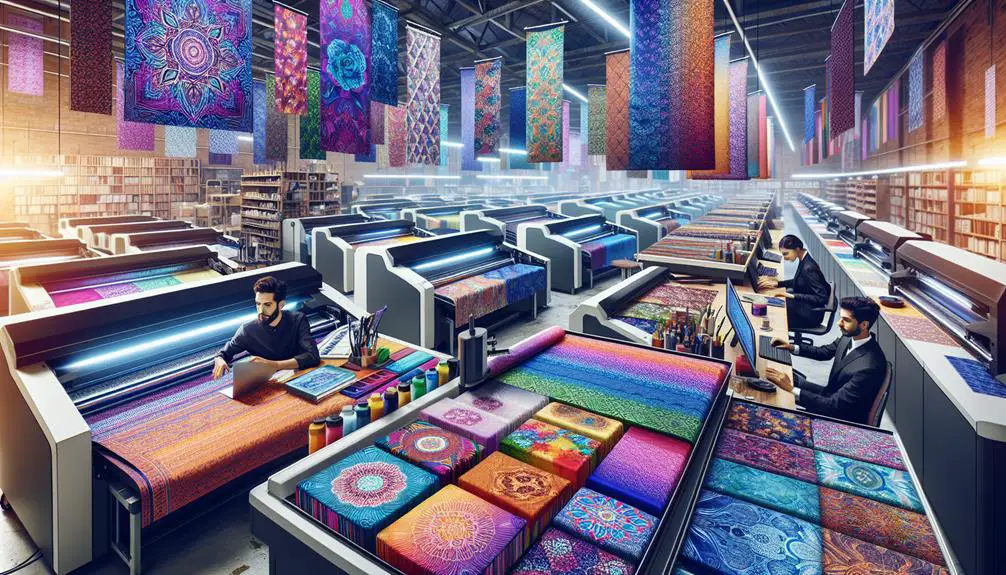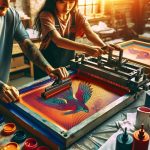Digital fabric printing uses advanced technology to apply stunning designs directly onto fabrics, offering unmatched precision and vibrant colors. It has evolved from ancient hand-block techniques to modern digital methods. You'll find various techniques like inkjet, dye sublimation, and direct-to-garment printing, each suited for different fabrics and purposes. This method is cost-efficient, sustainable, and ideal for both small and large batches. It's transforming fashion, home decor, and custom apparel industries. Essential equipment includes digital fabric printers and heat presses. Understanding fabric types and design considerations is key. Discover all these insights and more to master digital fabric printing.
Table of Contents
Key Takeaways
- Digital fabric printing allows for intricate designs and vibrant colors, suitable for both small batches and large production runs.
- Techniques such as inkjet, dye sublimation, and direct to garment (DTG) accommodate various fabric types like cotton, silk, and polyester.
- The method is environmentally sustainable, reducing waste and minimizing excess inventory through print on demand.
- Applications span fashion design, interior decoration, retail, and custom apparel, transforming the textile industry.
- Future trends include sustainability, customization, augmented reality integration, and advancements in smart textiles and ink technologies.
What Is Digital Fabric Printing?
Digital fabric printing is a modern method of creating designs on textiles using digital technology. You'll find it's a game-changer in the textile industry, offering unparalleled precision and flexibility. Unlike traditional methods, digital fabric printing uses advanced printing technology to directly apply designs onto fabric. This method allows for intricate patterns and vibrant colors that would be difficult to achieve otherwise.
One of the main advantages is its versatility. You can print small batches or large runs without compromising on quality. This is particularly beneficial for custom designs, limited editions, or prototypes. The process starts with a digital file of your design, which is then printed onto fabric using specialized printers. These printers work by jetting tiny droplets of ink onto the textile, resulting in high-resolution images.
Digital fabric printing also offers significant environmental benefits. It uses less water and energy compared to traditional dyeing methods, making it a more sustainable option in the textile industry. Plus, it reduces waste, as you can print only what you need.
History and Evolution
The journey of fabric printing has seen a remarkable transformation from ancient hand-block techniques to today's sophisticated digital methods. You might be amazed to learn how technological advancements have revolutionized this art form, making a global impact. In the early days, artists used carved wooden blocks to transfer dye onto fabric, a labor-intensive process that required significant skill and time. Fast forward to the 20th century, and screen printing became the norm, introducing more efficiency but still limiting artistic expression.
Today, digital fabric printing stands at the forefront, thanks to innovative techniques that allow for unparalleled precision and creativity. It's fascinating how this technology enables designers to bring their visions to life with just a few clicks, blending art and science seamlessly. Let's look at how fabric printing has evolved over time:
| Era | Method | Characteristics |
|---|---|---|
| Ancient Times | Hand-block Printing | Labor-intensive, highly skilled |
| 20th Century | Screen Printing | More efficient, less flexible designs |
| Modern Day | Digital Printing | High precision, limitless artistic expression |
These technological advancements have not only streamlined production but also expanded the horizons for artistic expression, making digital fabric printing a truly innovative and impactful industry.
Types of Digital Fabric Printing
When exploring the world of digital fabric printing, you'll come across several distinct types that each offer unique benefits and applications.
One of the most popular methods is inkjet technology, which uses tiny nozzles to spray ink directly onto the fabric. This technique is versatile and can produce high-resolution images, making it ideal for detailed designs.
Another method you'll encounter is dye sublimation, which involves transferring dye onto fabric using heat. This process works best on polyester fabrics and results in vibrant, long-lasting colors. Dye sublimation is perfect if you're looking to create items like sportswear or custom home décor.
Direct to garment (DTG) printing is another effective technique, where the ink is applied directly to the fabric using specialized printers. This method is excellent for small batch orders and offers a soft, natural feel on cotton fabrics. It's a go-to choice for custom t-shirts and fashion items.
Lastly, heat transfer printing uses a special transfer paper to apply designs to fabric with a heat press. This method is great for creating custom apparel and promotional items.
Each technique has its strengths, and understanding them will help you choose the right one for your projects.
Key Benefits
One major advantage of digital fabric printing is its ability to produce intricate designs with vivid colors. You can achieve a level of detail and vibrancy that traditional methods simply can't match. This precision makes it perfect for creating custom patterns and unique textiles.
Another key benefit is cost efficiency. Digital fabric printing doesn't require the lengthy setup time and extensive labor that conventional printing methods do. You can print smaller batches without incurring high costs, making it ideal for test runs and limited editions. This flexibility allows you to meet market demands quickly and economically.
Environmental sustainability is also a significant benefit. Digital fabric printing uses less water and fewer chemicals compared to traditional dyeing processes. The reduced waste and lower energy consumption make it an eco-friendlier option. Plus, the ability to print on demand means you're not left with excess inventory, further minimizing waste.
Common Applications
In today's fashion and textile industries, digital fabric printing is revolutionizing everything from haute couture to home décor. You're probably seeing its impact everywhere, even if you don't realize it. The flexibility and precision of digital printing make it perfect for creating custom apparel and unique home decor items. Whether you're in fashion design or interior decoration, digital fabric printing opens up a world of possibilities.
Here are some common applications:
| Application | Industry | Example Products |
|---|---|---|
| Custom Apparel | Fashion Industry | T-shirts, Dresses, Activewear |
| Home Decor | Interior Design | Curtains, Cushions, Upholstery |
| Textile Design | Fashion & Home Decor | Scarves, Tablecloths, Throws |
| Personalized Gifts | Retail | Tote Bags, Scarves, Pillows |
For fashion designers, digital fabric printing means you can create one-of-a-kind pieces without the limitations of traditional methods. Imagine producing a custom dress with intricate patterns that would be impossible to achieve otherwise. In home decor, the same technology lets you design everything from curtains to cushions, adding a personal touch to any space.
Printing Techniques
You'll find several printing techniques that make digital fabric printing incredibly versatile and efficient. Mastering these methods can transform your textile projects and elevate your creative potential.
- Direct-to-Fabric (DTF): This technique uses advanced inkjet technology, applying the ink directly onto the fabric. It's great for intricate designs and offers excellent color management. You'll achieve vibrant colors and fine details effortlessly.
- Dye-Sublimation: Ideal for polyester fabrics, dye-sublimation involves transferring dye onto the fabric using heat. The result is a permanent, high-resolution image that won't fade or crack. It's perfect for creating durable, vibrant prints.
- Reactive Printing: Using reactive dyes, this method is suited for natural fibers like cotton and silk. The dyes form a bond with the fabric, ensuring long-lasting and vivid prints. Reactive printing is highly regarded for its colorfastness and ability to produce deep, rich hues.
- Pigment Printing: Pigment inks sit on the surface of the fabric, making this technique versatile for various textiles. It's excellent for quick production and requires minimal surface treatments. Pigment printing is a fantastic option if you're looking for a straightforward and effective method.
Explore these techniques to harness the full potential of digital fabric printing and stay ahead in textile innovation.
Essential Equipment
Getting started with digital fabric printing requires some fundamental equipment that will guarantee your projects come out perfectly every time. First, you'll need a reliable digital fabric printer. This is the cornerstone of your setup and determines the quality of your prints. Invest in a printer that suits your needs, whether it's a large format for extensive designs or a smaller one for intricate patterns.
Here's a simple breakdown of what you need and why:
| Equipment | Purpose | Maintenance Tips |
|---|---|---|
| Digital Fabric Printer | Produces high-quality fabric prints | Regular cleaning, software updates |
| Heat Press | Fixes the ink into the fabric | Keep surfaces clean, check pressure |
| Computer & Software | Design and control printing processes | Update software, backup designs |
A heat press is essential for fixing the ink into the fabric, ensuring your designs are durable and vibrant. Proper maintenance of your heat press, like keeping the surfaces clean and ensuring even pressure, will keep your prints flawless.
Finally, a computer with the right software is vital for creating and controlling your designs. Regular updates and backups are key to avoiding disruptions.
Doing a printing cost analysis will help you manage expenses and maximize efficiency, ensuring you get the best return on your investment.
Choosing the Right Fabrics
When choosing fabrics for digital printing, you'll want to evaluate the type and properties of each material.
Some fabrics hold prints better, while others offer unique textures and feels.
Make sure your chosen fabric is compatible with your printing method to guarantee the best results.
Fabric Type Properties
Choosing the correct fabric for digital printing is vital to guarantee vivid colors and precise details in your designs. With a myriad of options, understanding the properties of each fabric type will help you make an informed choice.
- Silk Characteristics:
Silk is renowned for its luxurious feel and natural sheen. It's perfect for high-end projects where you need rich colors and a smooth texture. However, it can be delicate and requires special care.
- Cotton Properties:
Cotton is versatile and highly absorbent, making it a fantastic option for digital printing. It holds colors well and is durable, suitable for everyday wear and home décor. Its natural fibers secure comfort and breathability.
- Polyester Attributes:
Polyester is a synthetic fabric that provides excellent color retention and a smooth finish. It's durable, wrinkle-resistant, and ideal for sportswear and banners. However, it mightn't offer the same natural feel as cotton or silk.
- Linen Qualities:
Linen offers a unique texture and is highly absorbent. It's great for a rustic or natural look but can be prone to wrinkling. Its strength and longevity make it ideal for home textiles and sophisticated garments.
Print Compatibility Factors
Understanding print compatibility factors guarantees your designs come out vibrant and flawless on the chosen fabric.
Start by considering your printer requirements. Not all printers are compatible with every type of fabric. For instance, dye-sublimation printers work best with polyester fabrics, while direct-to-garment printers excel on cotton. Confirm your printer matches the fabric type you want to use to avoid disappointing results.
Next, focus on fabric selection. Different fabrics have unique properties that affect how they absorb and display ink. Natural fabrics like cotton and silk tend to absorb more ink, resulting in bolder colors, but they also require specific pretreatment processes. Synthetic fabrics, such as polyester, often need specialized inks and treatment methods to achieve the best results.
Also, consider the fabric's weave and texture. Tight weaves and smooth textures generally produce crisper images, while loose weaves and textured surfaces can distort finer details.
Always test a small sample before committing to large-scale printing to confirm compatibility.
Design Considerations
When you're planning your design, think about your color and pattern choices and how they'll look on different fabrics.
Some materials may not hold certain colors well, so it's vital to match your design to the right fabric.
This guarantees your final product looks just as fantastic as you envisioned.
Color and Pattern Choices
Selecting the right colors and patterns can make or break your digital fabric printing project, so let's explore some key design considerations.
First, understanding color psychology is essential. Different colors evoke various emotions and reactions. For example, blue often conveys calmness, while red can evoke passion. Consider how your color choices align with the fabric's intended use and the mood you want to create.
Next, think about the fabric drape. How a fabric falls or hangs can impact how colors and patterns appear. A flowing fabric may distort a bold pattern, while a stiff fabric might maintain its integrity. Experiment with samples to see how your design looks in motion.
Pattern scaling is another crucial factor. The size of your pattern can significantly alter the design impact. Large patterns can be striking but might overwhelm smaller items. Conversely, small patterns can add subtle elegance but may get lost on larger pieces.
Finally, keep the overall design impact in mind. How do the color and pattern work together to create a cohesive look?
Here are four key tips for mastering color and pattern choices:
- Understand color psychology and its effects.
- Consider the fabric drape.
- Experiment with pattern scaling.
- Aim for a cohesive design impact.
Fabric Material Compatibility
Choosing the right fabric material is essential for ensuring your digital print designs look their best and last long. When it comes to material selection, you need to take into account not just the fabric's texture and feel, but also its compatibility with digital printing. Different materials have unique fabric requirements and printing limitations that can affect the final outcome.
Here's a quick guide to help you navigate the options:
| Fabric Type | Factors to Keep in Mind |
|---|---|
| Cotton | Great for vivid colors but may shrink; treat first. |
| Polyester | Excellent ink adherence; ideal for sportswear. |
| Silk | Delicate; requires specialized inks and handling. |
| Linen | Absorbs ink well; may show natural texture. |
| Nylon | Needs pre-treatment; good for outdoor fabrics. |
For example, cotton is a popular choice due to its absorbency, but it can shrink, so pre-treating is crucial. Polyester, on the other hand, offers excellent ink adherence, making it perfect for vibrant sportswear.
Understanding fabric requirements will help you avoid common printing limitations. Always test a small sample of your material to make sure it meets your design needs. By mastering these factors, you'll be well on your way to creating stunning digital prints that stand out and endure.
Future Trends in Digital Fabric Printing
Digital fabric printing is evolving rapidly, and staying ahead of the trends can give you a competitive edge. Embracing future trends is essential for mastering the craft and meeting market demand.
Here are four key trends to watch:
- Sustainability Practices and Technological Advancements: As consumers become more environmentally conscious, adopting sustainable practices is pivotal. New technology is making it easier to use eco-friendly inks and fabrics, reducing waste and energy consumption.
- Customization and Personalization: Today's consumers crave unique products. Leveraging advancements in digital fabric printing allows you to offer personalized designs, meeting specific consumer preferences and increasing customer loyalty.
- Smart Textiles: The integration of technology into fabrics is a growing trend. From fabrics that change color with temperature to those that can monitor health metrics, smart textiles are set to revolutionize the industry. Staying updated on these innovations can position you as a leader in the market.
- Enhanced Print Quality and Speed: With ongoing technological advancements, print quality and production speed continue to improve. Investing in the latest printers can help you deliver superior products faster, meeting the increasing market demand.
Frequently Asked Questions
How Do I Troubleshoot Common Issues With Digital Fabric Printing?
Start by checking color calibration and ink smudging. Then, verify print head alignment and fix any fabric feed issues. You'll master troubleshooting by addressing these key areas, guaranteeing smooth, flawless digital fabric printing.
Are Eco-Friendly Inks Available for Digital Fabric Printing?
Yes, you can find eco-friendly ink options for digital fabric printing. These inks support sustainable printing practices by reducing environmental impact. Look for water-based or biodegradable inks to make sure you're making eco-conscious choices in your projects.
What Safety Measures Should Be Taken During the Printing Process?
You should follow strict safety protocols, including proper ventilation. Always wear protective gear to prevent chemical exposure. Ensuring a safe work environment helps you master the printing process without compromising your health.
How Do I Maintain and Clean Digital Fabric Printers?
To keep your digital fabric printer in top-notch shape, think of it like maintaining the Enigma machine. Follow these cleaning tips: dust regularly, use gentle solvents, and stick to recommended maintenance procedures for longevity and peak performance.
Can Digital Fabric Printing Be Used for Custom Sportswear?
Yes, you can use digital fabric printing for custom sportswear. It allows you to create unique designs on performance fabrics, ensuring your gear stands out while maintaining the functionality and comfort needed for athletic activities.
- Tetron Fabric for Marine Applications: Durability and Use Cases - June 18, 2025
- Tetron Fabric for Outdoor Furniture: Weather Resistance and Care - June 18, 2025
- Tetron Fabric for Wall Coverings: Style and Application Tips - June 18, 2025







